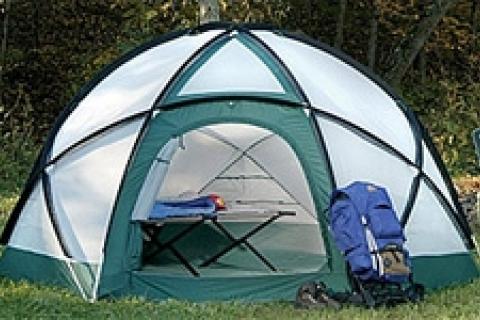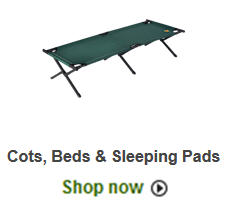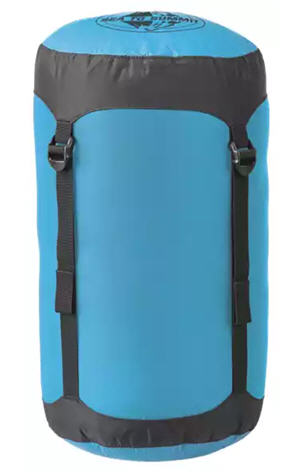
You never really know how limited space is in a camping tent until you're forced to spend several hours in it seeking shelter from a heavy rainstorm. Of course, the actual size of the tent and the number of people in it impacts available space, but there are interior options, accessories and packing habits that can help you maximize tent space and interior comfort. Here are a few tips on how to make the most of the space inside your tent.

designs will suit your needs better than
others.
Haven't Bought Your Tent Yet?
If you haven't bought a tent yet, here are a few words of advice on spacing. Buy a tent that's rated at least one, if not two, persons larger than the number you intend to have sleep inside it. This is a good rule of thumb unless you're concerned about the size and weight of a packed tent. The first tent I bought was a two person; with two people in its tight quarters there was barely room to move around. The lesson I learned is that I should have bought at least a three- or a four-person tent, to accommodate backpacks and spare clothes in the tent.
Tip: Buying a Tent? Here's a Guide to Make the Perfect Choice (infographic)
 Another thing to consider when buying a tent is its footprint and shape. Not all tents are created equal and some designs will suit your needs better than others. You can measure the length and width of your sleeping bag and pad (or camping cot) to ensure the tent has enough space to fit your gear with a bit of extra space. If stores have tents set up, get inside and lie down and bring in a few items to ensure you'll have enough space. Keep in mind you want extra room at the tent's sides to ensure you've got enough space for gear once you load it in. If family camping, getting a tent with dividers can break up space for gear versus sleeping, and dividers with zippers will let you go to an open concept when people are hanging out in the tent.
Another thing to consider when buying a tent is its footprint and shape. Not all tents are created equal and some designs will suit your needs better than others. You can measure the length and width of your sleeping bag and pad (or camping cot) to ensure the tent has enough space to fit your gear with a bit of extra space. If stores have tents set up, get inside and lie down and bring in a few items to ensure you'll have enough space. Keep in mind you want extra room at the tent's sides to ensure you've got enough space for gear once you load it in. If family camping, getting a tent with dividers can break up space for gear versus sleeping, and dividers with zippers will let you go to an open concept when people are hanging out in the tent.

Consider a dome-style tent or cabin-style tent like the Coleman Weathermaster 10-Person tent for plenty of overhead room, unless you're concerned about weight and tent pack-size. These tents let you sit up comfortably and in some models you can crouch or stand inside. Being able to move around freely in the tent will help you keep your entrances and exits quick, equating to fewer bugs than cramped campers stuck fumbling with zippers or tripping over door bases. Extra space will also pay off if you ever get stuck in the tent in a rain storm, preventing the feeling of claustrophobia that tiny tents can create.
Tent Accessories, Carving Out Space
Once you've bought a tent, the next step is being creative and using accessories to maximize the interior space. The first thing to do is determine the best way to use the storage space in your tent. If possible, store items outside instead of cramming all your gear into the tent. In most cases hanging food is the safest bet to discourage animals from invading your camp site. Other gear can be kept in a car, under a canoe, wrapped in a tarp, or tucked under the tent's vestibule.
 When inside, it's best to take advantage of the tents internal pockets and compartments to store gear and clothing. Most tents come with a hanging organizer or storage system that clips into poles or loop holes and hangs from the ceiling. You can easily expand the storage capacity of these units by running rope or stretch cords under them again and make a great inside clothesline or flashlight holder, just make sure you don't overload the loops with too much weight.
When inside, it's best to take advantage of the tents internal pockets and compartments to store gear and clothing. Most tents come with a hanging organizer or storage system that clips into poles or loop holes and hangs from the ceiling. You can easily expand the storage capacity of these units by running rope or stretch cords under them again and make a great inside clothesline or flashlight holder, just make sure you don't overload the loops with too much weight.
If you're sleeping with a cot, use the space underneath it to store gear. There are cot organizers and bags that hang over the sides to keep items organized and within reach. If sleeping on an air mattress or pad, keep backpacks and other items off the sleeping area. Pile items on top of each other or store them in the tent's other compartments. Don't let items touch the tent walls as condensation can accumulate on cool nights and dampen items.

To store clothes use compression bags or sacks like the Sea to Summit Compression sack to cut down on the space requirements of these items. Travel organizers can also be handy to keep all your toiletries and personal items in one bag. This allows you to only have the things you really need in one small bag, while other items can be packed away in larger bags.
TIP: How to Choose the Best Sleeping Bag for Camping
Cutting Down on the Stuff You Bring Camping
One of the biggest things you can do to increase the space in your tent is to minimize the amount of stuff you bring camping. No where is this more true than with clothes. Following the layering rule to outdoor wear (to add on or take off layers to regulate temperature) is a better option than bringing clothes only for specific temperature ranges. Many outdoor clothes today are also synthetic blends and can be compressed easily, a lot better than a bulky wool sweater anyway. Reducing the amount of clothes you bring will dramatically impact the amount of space in your tent.
TIP: Print out the camping checklist here, then check it off the checklist while you load up.
The same reduction thinking is important to keep in mind when packing for your trip. Consider what items can perform double duty. For example, stuffing extra clothes into a pillow case reduces the need for you to pack a pillow. Another example is the rope used to secure items in a canoe can double as a clothesline (whether in the tent or out) instead of bringing extra rope.
Tents can be tight on space but options do exist to keep them comfortable and somewhat roomy. The key to tent comfort is choosing the right sized tent, bringing only the items you need, and using organizing accessories to maximize interior storage space. The inside of a tent will never be as good as your bedroom at home but hey, isn't that what the outdoor experience is all about?
- 16428 views

